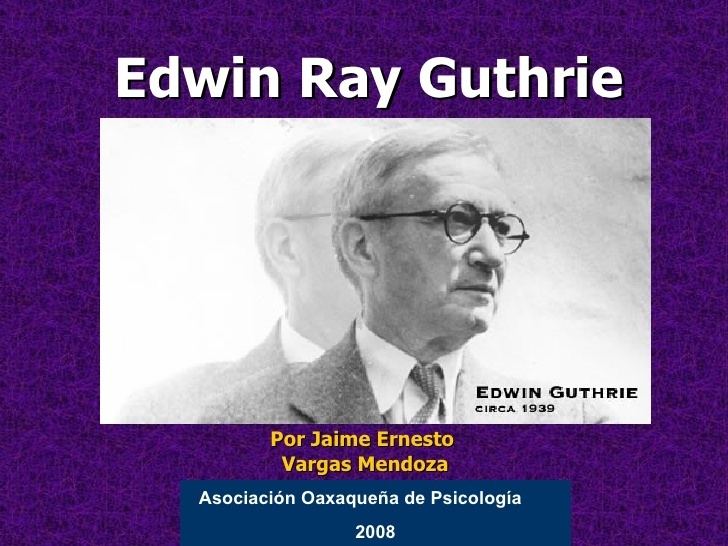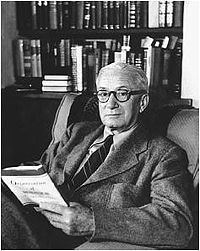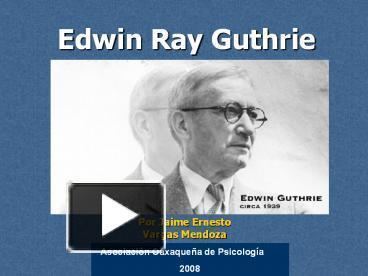Known for One Trial Theory Role Psychologist | Spouse Helen MacDonald Name Edwin Guthrie | |
 | ||
Born 9 January 1886Lincoln, Nebraska ( 1886-01-09 ) Died April 23, 1959, Seattle, Washington, United States Education University of Pennsylvania Books The psychology of learning Similar James Townsend (psychologist), David Rumelhart, William Kaye Estes | ||
Edwin Ray Guthrie
Edwin Ray Guthrie (; January 9, 1886 in Lincoln, Nebraska – April 23, 1959 in Seattle, Washington) was a behavioral psychologist. He first worked as a mathematics teacher, and philosopher, but switched to psychology when he was 33. He spent most of his career at the University of Washington, where he became full professor and then emeritus professor in psychology.
Contents
- Edwin Ray Guthrie
- Teori PembelajaranBehavioristik Menurut Edwin Ray Guthrie
- Early life and education
- Psychology interest
- One trial theory
- Punishment
- Breaking habits
- Historical relevance
- Guthrie on education
- References
Guthrie is best known for his theory that all learning was based on a stimulus–response association. This was variously described as one trial theory, non-reinforcement, and contiguity learning. The theory was:


One word that his coworkers and students used to describe Guthrie and his theories was "simple", and perhaps he did prefer to use simple terms to illustrate complex ideas. However, "It is undoubtedly true that many reviews of Guthrie in the literature have mistaken incompleteness for simplicity".

His simple nature carried into his teachings where he took great pride in working with and teaching students.
Teori Pembelajaran_Behavioristik Menurut Edwin Ray Guthrie
Early life and education
Guthrie was born in Lincoln, Nebraska, to a father who owned a store selling pianos and bicycles, and a mother who was a school teacher. He remarked that his theories got an early start when he and a friend read Darwin’s Origin of Species and The Expression of the Emotions in Man and Animals while they were both in eighth grade. Guthrie graduated at the age of 17 after writing a rather inflammatory senior thesis that argued "that both science and religion, being dependent on words, and words being symbols dependent for their meanings on the experience of their users and auditors, would have no chance at expressing Absolute Truth". Guthrie received the title of lay reader in his local Episcopal Church while pursuing a philosophy degree from the University of Nebraska. This university he credited with helping him pursue his varied interests because "the university had none of the present apparatus of required courses and set curricula. . . . This freedom made possible the inclusion of courses in both Latin and Greek which had been begun in high school; mathematics through calculus"
Psychology interest
While Guthrie was going to graduate school he was the only student in a seminary taught by Wilhelm Wundt’s protégé H. K. Wolfe, where they debated the philosophy of science. Guthrie later characterized the classes that he took for his degree as philosophy courses that "took much interest in issues that would now be recognized as psychological". His focus upon a theoretical approach to psychology as opposed to an experimental research approach can be found in his account of his single experimental psychology course which he described as "a research course under Bolton devoted a winter to observations with an aesthesiometer on the limen of twoness, and served to quench [my] interest in psychophysics, which was the chief preoccupation of psychological laboratories in those times".
His professional psychology career did not start in full until he met Stevenson Smith, who founded the psychology department at the University of Washington in 1917. Guthrie and Smith helped write Chapters in General Psychology in 1921. This book and work with Smith, focused Guthrie's continuing psychological works towards how exactly learning works and what effects a persons capability of learning. He and his wife, Helen MacDonald, traveled to France where they met Pierre Janet. Janet’s writing had a great impact on Guthrie’s thinking, so profound in fact that Guthrie and his wife translated Janet’s Principles of Psychology together. Guthrie added to Janet’s writings an objective theory of learning.
One trial theory
Guthrie’s theories went against those of Watson’s classical conditioning and Skinner’s operant conditioning due mainly to Guthrie’s insistence that their "desire for results of immediate practical applications" led to their theories being wrong. Guthrie’s learning theory is called one-trial learning and he developed it with Smith at the University of Washington. Guthrie and Smith’s theory states that all learning is done within a single exposure to a situation. Guthrie admitted that his own theory required the assumption that people react to a given situation the same way so long as it was still effective. Guthrie’s more ambiguous theories and assumptions were put into more understandable terms after his death. These notes focused upon the following three principles, the principle of association, the principle of postremity, and the principle of response probability.
Punishment
Guthrie also had theories as to how punishment worked that were at odds with the likes of Thorndike and other learning theorists of his own time. Guthrie thought that punishment was only as effective as the amount of change in behavior the punishment caused. Guthrie’s theory required that presentation of punishment happen while the stimulus is still around. He did warn that if the punishment did not stop the undesirable response or if it was not presented in the presence of the stimulus that the punishment could actually strengthen the undesired response.
Breaking habits
Guthrie believed that dozens of tiny movements make up what most see as a single behavior; much like waving good-bye actually involves dozens of muscle movements. Guthrie viewed habits as a response connecting with a large number of stimuli, which causes the habit to happen more often to a wide variety of things. He postulated that there were three different ways to break a habit, the threshold method, the fatigue method, and the incompatible response method.
Historical relevance
According to his students, Guthrie’s writings and theories were intentionally vague and "ambiguous" much to his insistence on his work not being biased in a similar fashion and due to this resulted in most of his theories not being tested while Guthrie was alive. Thankfully, his peers and students turned his theories into more precise ideas that allowed experiments to test them. His theories on learning were wrong but his ideas about behaviorism helped make the case that Psychology as a whole had important applications to real life issues. His real effect on the course of Psychology however, came from those he left behind. His student Voeks was the one who formalized Guthrie’s theories into a more testable form and his colleague William Kaye Estes took Guthrie’s ideas and created a statistical theory of learning that he is now famous for.
Guthrie on education
Edwin Ray Guthrie was interested in the application of psychology and his learning theories in education. In the preface of his book Educational Psychology (1950), he states, " … the ultimate test of a theory of learning is its influence on the all-round growth of young people when applied in the classroom." He hypothesized that pairing a stimulus and response could result in learning after only one trial. Guthrie believed that learning takes place through association and conditioning, and one pairing is often enough to establish a connection, rather than repeated stimulus-response pairings. These association and connectionist theories are the bases of Guthrie’s contiguity theory of learning. The law of contiguity refers to associating, or learning, two stimuli or events that occur simultaneously. When the stimulus and response occur together, they are learned due to the connection of their contiguity.
Guthrie acknowledged the use of reinforcement and rewards, but he did not deem them necessary for learning. He believed that organisms played a large part in their learning when developing habits and skills due to "movement-produced stimuli." Therefore, he asserts that the students do not learn from what the teacher does, but from what they do themselves. In other words, students do not learn something merely by hearing or reading it; rather, the information must elicit an "active response" in the learner. He believed that the ideal school environment is one that permits "freedom of responsible action." He advocated for an environment that does not repress individual differences but rather appreciates them and allows the students as much self-direction as possible. Guthrie described that an effective teacher would be one that would modify and revise the content of their lessons because students are dynamic in their learning and are "constantly organizing and reorganizing experiences." According to Visible Learning for Teachers (2012), which evaluates effective teaching strategies, Hattie makes a significant point to advocate for flexible, adaptable instruction that is modified by the students’ prior knowledge, experiences, and individual differences as well as their rates of learning.
The applications of Guthrie’s theories have carried on to present education practices. In Educational Psychology (1950), he asserted that effective study skills included a clear goal, mastery of fundamentals, knowledge of learning phenomena, concentration, and practice. There is evidence that goal setting is indeed effective in learning and retaining material. Similarly, Guthrie advocated for making clear objectives for student learning by connecting the target response to the educational stimulus. Although he believed in one-trial learning, Guthrie valued practice in the classroom. The purpose of practice is to ensure that students continue to "relearn" the material because of the uniqueness of each learning experience. He asserted that distributed, or spaced, practice is the most effective and efficient method for learning and retaining content. Distributed practice has indeed been shown to be highly effective in improving student learning and is recommended for use in classrooms today.
